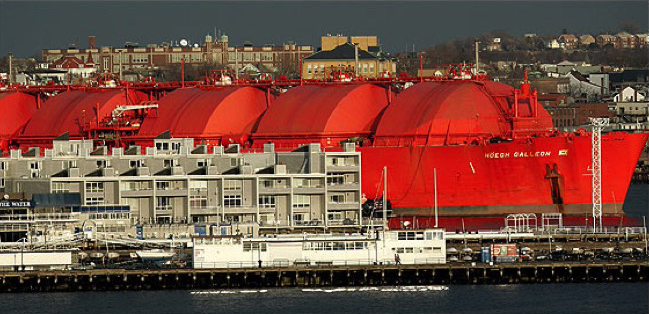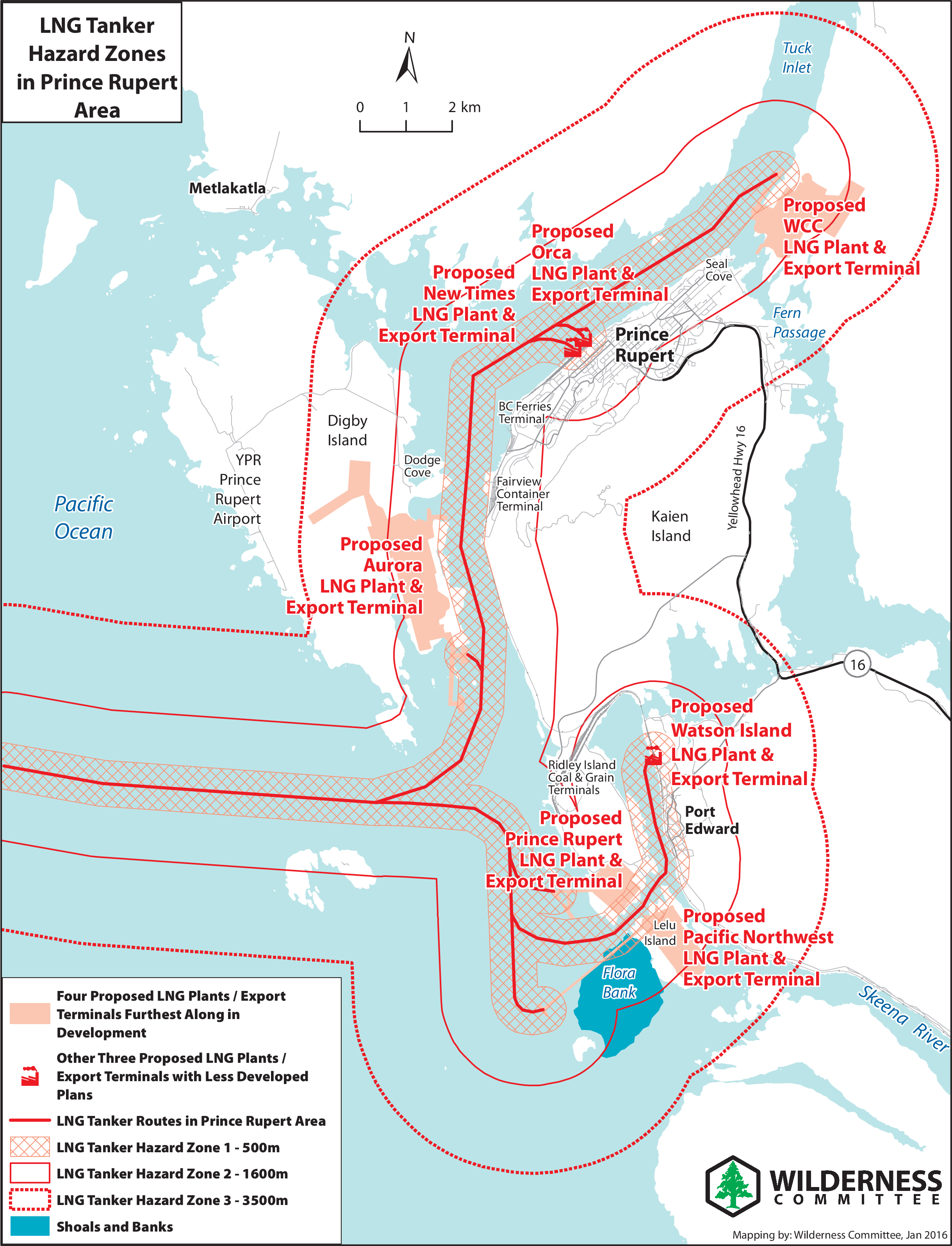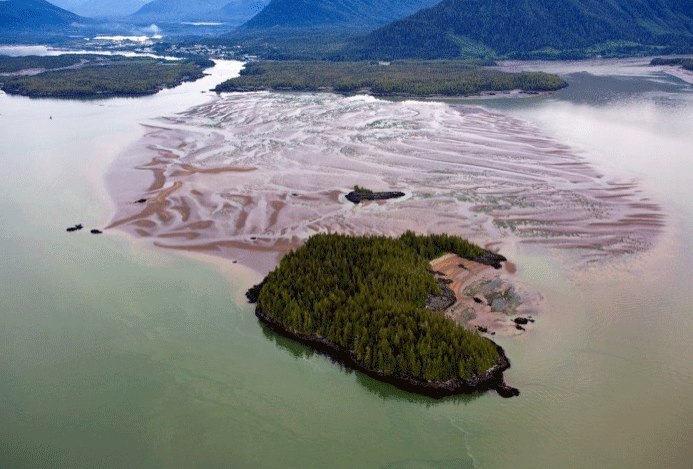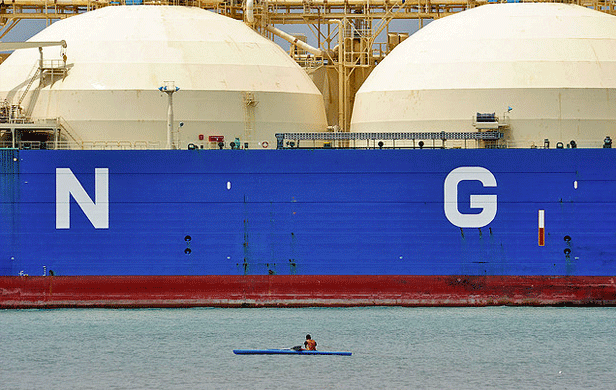
By Graeme Pole
The Merriam-Webster dictionary defines due diligence as: “The care that a reasonable person exercises to avoid harm to other persons or their property.” As the debate on British Columbia’s proposed liquefied natural gas (LNG) industry enters its fourth year, it is past time to bring one aspect of that industry under scrutiny – the safety of people in proximity to LNG vessels and terminals.
Breaking all the rules
The default document on this topic is one created by the LNG industry itself. In 1997, the Society of International Gas Tanker and Terminal Operators (SIGTTO) published Site Selection and Design for LNG Ports and Jetties. The document is clear and succinct in describing how to enhance LNG safety:
- LNG ports must be located where LNG vapors from a spill or release cannot affect civilians.
- LNG ship berths must be far from the ship transit fairway to prevent collision, and since all other vessels must be considered an ignition source.
- LNG ports must be located where they do not conflict with other waterway uses now and into the future.
- Long, narrow inland waterways are to be avoided, due to greater navigation risk.
- Waterways containing navigation hazards are to be avoided as LNG ports.
Anyone familiar with the marine approaches to Prince Rupert and Kitimat will be aware that to propose marine transport of LNG from terminals in those harbours violates all of the SIGTTO standards referred to above.
Prince Rupert at Risk
Although industry analysts agree that not all will be built, four large terrestrial LNG export facilities are proposed for the Prince Rupert area, along with three, smaller floating facilities. At full build-out, the large plants would generate 796 round-trip transits of LNG vessels into port, the smaller facilities 208. That’s almost three round-trips per day. In 2014, the Prince Rupert Port Authority reported that 494 vessels called at port terminals to take on and offload trade resources and goods, and that was a year when coal export was markedly down.

Key concerns are not just that LNG export could triple industrial vessel transits at Prince Rupert, and that the BC government sees no harm in promoting that possibility. Vessels in the Q-Max LNG carrier class are 345 metres long with a capacity of 266,000 cubic metres of LNG, comparable in size to the large ships that now dock at the Fairview Container Port.
The potential tripling of marine traffic at Prince Rupert would principally involve extremely large vessels carrying a dangerous commodity in a confined waterway.
Russian Roulette
The likelihood of a breach to one of the five or six storage tanks on a typical LNG vessel – whether accidental or intentional – is low. It has not happened since LNG marine transport began in 1959. But LNG itself as a substance, through its manufacturing process and in its steady-state in storage, possesses innate hazards. LNG terminals and storage facilities have suffered catastrophic explosions.
As more vessels are added to LNG fleets, making more voyages into confined and treacherous waters such as found on BC’s north coast, the chances of at least an accidental breach in a marine setting will increase. World events of the past two decades indicate that the risk of an intentional breach cannot be dismissed. For the LNG industry to tout past “safe” performance as an absolute indicator of future probability is hubristic.
Cold Explosion
What would happen if LNG were to escape from a marine vessel storage tank? In 2004 and 2008, the US Department of Energy commissioned Sandia National Laboratories to find out. Sandia reported that an instantaneous fireball would not be likely. What would be more likely is a “cold explosion” known as a rapid phase transition. The temperature of LNG is -161.5°C. Escaping from a vessel, LNG would release a blast as it froze the ocean surface, then evaporate as it warmed and picked up water vapour to form a low, heavier-than-air vapour cloud that would drift outward. The larger the breach, the larger the cloud.
Outright ignition of regasified LNG would require it to mix with air in a range of 5 percent to 15 percent LNG. If this cloud of LNG vapour were to spread from a vessel or a terminal with optimal conditions for ignition, an aerial fireball would be possible. That ignition would typically “backtrack” from the spark to the source of the cloud. But with an onshore wind a fiery blanket could disperse over land. Sandia’s research suggested that typical aerial dispersal distances from a small breach would be 3050 m from a near-shore source, and 4600 m from an offshore source.
Hazard Zones

LNG burns at more than 500°C. Sandia’s reports described three zones of hazard around an LNG vessel should a breach occur with ignition. Within 500 metres of the vessel, death to all living things on the water, surfacing from the water, in the air, or on adjacent land would be likely. This could result from shrapnel, incineration, cryogenic freezing or from suffocation. Between 500 metres and 1.6 km from the vessel, these threats lessen but are still critical. Second-degree burns to exposed human flesh would typically result from 30 seconds of exposure.
Structural fires, grass fires, and forest fires would be ignited. Effects would lessen moving from 1.6 km out to 3.5 km, beyond which the hazard is considered negligible. In the US, these hazard zones have been embodied in regulations governing LNG facility location. It is also standard for LNG ports to have fireboats that are foam-capable, as use of water on an LNG-fed fire would exacerbate it.
Plotting the Sandia hazard zones along the shipping lane at Prince Rupert is informative. All human settlement in Prince Rupert, Port Edward, Dodge Cove, and Seal Cove is within the hazard zones. More than 13,000 residents are at risk, along with up to 3,000 people who may be visiting at any given time. More than 60,000 passengers depart the port on ferries and water taxis each year in these hazard zones.
If this information can be gleaned from reliable sources on the Internet (such as Government of Canada and Prince Rupert Port Authority websites), with distances confirmed using Google Earth, be assured that the BC government, federal government, and the LNG industry are aware.
In harm’s way

LNG vessels transiting to the proposed WCC LNG facility on Tuck Inlet (across Fern Passage from Seal Cove) would ply the length of the Prince Rupert Harbour shipping lane and its approaches. The Fairview Container Terminal is on the verge of the 500-metre hazard zone, as is a 4 km length of the CN Rail line. The Coast Guard base, City Hall and its Emergency Operations Centre, the Fire Hall and its 911 call centre, the Prince Rupert Port Authority with its Port Security Operations Centre and Emergency Operations Centre, the BC Ferries and Alaska Marine Highway terminals, the Via Rail terminal, the Seal Cove Coast Guard Search and Rescue helicopter base and BC Ambulance medevac base, and the RCMP detachment all lie within 1.6 km of that shipping lane. Prince Rupert Regional Hospital and the BC Ambulance station are on the 1.6 km line.
To cement brazen disregard for the SIGTTO guidelines, LNG vessels approaching WCC LNG would pass other LNG vessels berthed for loading at the proposed Aurora LNG facility on Digby Island, at a point where the navigable waterway is scarcely 1 km wide. They would also pass LNG vessels docked at New Times LNG and Orca LNG on the Prince Rupert waterfront.
Boston-bound LNG ships require armed escort
Boston is the only US city with an LNG facility. The Everett terminal in Boston Harbour imports LNG – meaning that vessels enter the harbour loaded and leave empty – the opposite to what is proposed for BC’s north coast. Typically, only one LNG vessel every eight days makes the trip to Everett LNG, but the stir that each passage creates is instructive in terms of appraising risk.

When four days from port, an LNG vessel approaching Boston must contact the US Coast Guard with a manifest and crew list. The Coast Guard runs checks on the crew. When 12 miles from port, the Coast Guard boards the vessel to inspect it and to begin surveillance to ensure that all other vessels keep 500 yards away. When five miles out, a pilot boards the vessel and four tugboats are engaged. Passage into port is only permitted in daylight and with clear visibility.
Five armed boats, two from the Coast Guard and one each from three police agencies, escort the LNG vessel into harbour. Law enforcement officers patrol all piers and jetties along the route, with a helicopter or two dedicated to observe from above. Bridge traffic over the harbour is halted as the vessel makes way beneath. Marinas are shuttered and guarded for 20 minutes before and after each transit. The security cost? About 80,000 USD per transit. The economic cost? Unknown.
Tight restrictions on lone Atlantic Canada import port
The Port of St. John, New Brunswick, is home to Canaport LNG, Canada’s only LNG import facility. Transport Canada has implemented Boston-like measures for LNG transits: mandatory security screening of LNG vessel crews; a “marine safety zone” of 0.5 nautical miles (926 m) around any LNG vessel; no anchoring within 1.5 nautical miles of an LNG vessel; and no overtaking of LNG vessels when they are underway in the harbour.
When an LNG vessel is offloading at Canaport LNG, a 620 m radius from the centre of the terminal is off-limits to all marine traffic except tugs and service craft employed with that vessel. Given the large “sail areas” of LNG vessels, the harbour master may consider other “special provisions” to accommodate them, or may order them to leave port when they are empty and it is windy.
Harper rejected LNG on East Coast

In 2006 and 2013, the Canadian government rejected plans for LNG vessel transits through Head Harbour Passage and Passamaquoddy Bay, New Brunswick, to a proposed LNG facility in Maine. Describing those Canadian waters as “a unique and highly productive marine ecosystem,” the 2013 letter from the Canadian ambassador to the US Federal Energy Regulatory Commission summarized concerns related to “the environmental, navigational, and safety risks as well as the adverse economic consequences…”. Which begs the question: What is so different about the setting for LNG vessel traffic proposed for BC?
Although piloting will be required, Transport Canada has not announced its plans for LNG carriers on BC’s north coast. According to its website, the Prince Rupert Port Authority is considering implementing “safe transit zones” and “traffic separation patterns to define specific routes for specific types of vessels.” In other ports, separations of as much as an hour are required between LNG carriers and other watercraft.
What about other boaters?

What if, as is likely, setbacks and separations are mandated around LNG vessels approaching BC’s north coast? For one thing, LNG plants with planned multiple berths (Aurora, Pacific Northwest, and WCC) would not be allowed to have more than one LNG vessel at dock. But of greater importance, with the possibility of three LNG vessels a day entering and three a day exiting the port of Prince Rupert, what would be the effect on BC Ferries, the Alaska Marine Highway, the airport ferry, the Metllakatla ferry, water taxis, commercial fishing (especially salmon and herring openings), tour operators, cruise ships, and recreational boating and fishing?
Why aren’t these potential economic impacts and inconveniences being weighed against the touted benefits of the LNG industry? Although the issue was raised by the public during “consultation,” why wasn’t the possibility of restrictions to marine traffic included in the descriptions of any of the proposed LNG projects? Is it because the backlash would be over public safety, not mere inconvenience? And who in government has investigated the insurance requirements for LNG carriers and ports? Each LNG vessel is typically its own limited liability company, flying a flag of convenience; its owners beyond the reach of law should calamity occur.
Practice what you preach
Last words on the issue of LNG marine safety and due diligence go to those responsible – industry and government:
[quote]Engaging with our stakeholders in open and honest dialogue is a critical part of the way we do business and essential in helping us to understand concerns, share information and build strong relationships. In carrying out these activities, we are guided by five principles: inclusion, respect, timeliness, responsiveness, and accountability. -WCC LNG Project Description[/quote]
[quote]If spilled, LNG evaporates into the atmosphere, leaving no residue on either soil or water. No environmental cleanup is required. -BC government website, LNG fact card #5[/quote]
Graeme Pole lives near another LNG “ground zero” – in the Kispiox Valley, near the route of the Prince Rupert Gas Transmission Project.


Peter Helland, do you like shooting yourself in the foot or more likely blowing yourself up? That is what our dear leaders are doing to us and the environment by pushing LNG. Yes the inconvenient truth of climate change which LNG will exacerbate plus all the polluted water, risk to human safety and violation of First Nations rights, etc.
Nor is there an economic argument for it. Nothing to do with doom saying but real facts.
Getting tired of hearing from the “doomsayers”..there’s an element of danger in crossing the street too..that’s why we stop,look and listen..if the original settlers to this land took your attitudes they would never have set foot ashore
First, sometime we need to cross the street. We don’t need LNG, nor will it benefit British Columbians in any way, shape or form.
Second, if one person crosses the street and gets hit by a car, too bad for them. If an LNG tanker runs aground, producing the kind of vapour cloud described in this article and that meets with an ignition source, too bad for thousands of people.
Third, I’m sure there are more than a few indigenous peoples in the very communities these LNG projects are proposed who sincerely wish settlers never set foot ashore. LOL
really and so what are you saying ??
LNG facilities are in our national interest…or giant atomic like bombs that could blow thousands to their deaths and kill every fish for miles.…site C dam feeds tar-sands and imaginary electric cars…or has no purpose…kinder morgan is necessary so Vancourver can grow…or big-oil can export it and make a few dollars per barrel more…Protestors are now being called terrorists…or saviours of seven generations.…if you can’t any of this your granchildren will spit in your faces.
Merriam-Webster also defines ‘a reasonable person’ as one…
-having sound judgement
-sensible
-rational
-logical
-fair
-fair minded
-just
-equitable
-intelligent
-wise
-level headed
-practical
-realistic
-sound
-well reasoned
-valid
-commonsensical
-tenable
-plausible
-credible
-believable
I am hard pressed to attribute even one of those reasonable attributes to our present governors and most especially vacant in our preemy and the gaseous minister coleman.
LNG facilities also invite attack during war.
Hey- all the same issues exist for the LNG plant in Howe Sound but then the ships will only pass through a population of around 20,000 people people living along the Howe sound shipping route and a few hundred thousand more around the Salish Sea and west side of lower Mainland. Bad for the goose in northern BC and the gander in the south! Let’s talk about the complete issue instead of dividing our coastal province!
Thanks for your comment, Annie. I assure you there was no intent to divide. There is an urgency at Prince Rupert, as Pacific Northwest LNG could receive a go-ahead from the federal government within a few weeks. The “complete issue” is that this proposed industry is ludicrous – environmentally, economically, and socially. Informing 13,000 people that they are but one regulatory approval away from living in a potential incineration zone is part of the education. Let’s keep at this, together.
Looking at the map, it would seem that the PNW LNG project is the safest of them all. Lelu Island might prove to be the best location after all
lelu and flora bank will never be an lng site. loving the no sayers.
It is right alongside Port Ed community. They are not safe.
NO Prince Rupert is not safe, the pollution will have disasterous effects on our air quality. I like the fact that Prince Rupert is not being polluted by a care less industry. We now await the day all our waters are healthier due to leaving the environment to heal. Lng is a pollution nightmare, Im not here to help the screwing over of earth. I do wonder why you think your safety bubble will allow you the luxury of escaping whats coming our way already. Lng will make our time on earth worse, faster. Why dont you know this?
We’ve published 50 or more stories on the dangers of WFLNG in these pages, Annie – and will continue to. Graeme is a northerner speaking from experience about the projects that directly confront his region and community. I think he’s entitled to that and I don’t think either he or this publication can fairly be accused of dividing the coast. That said, you are absolutely correct that the same issues apply on the South Coast, which is, incidentally, right in my own back yard.